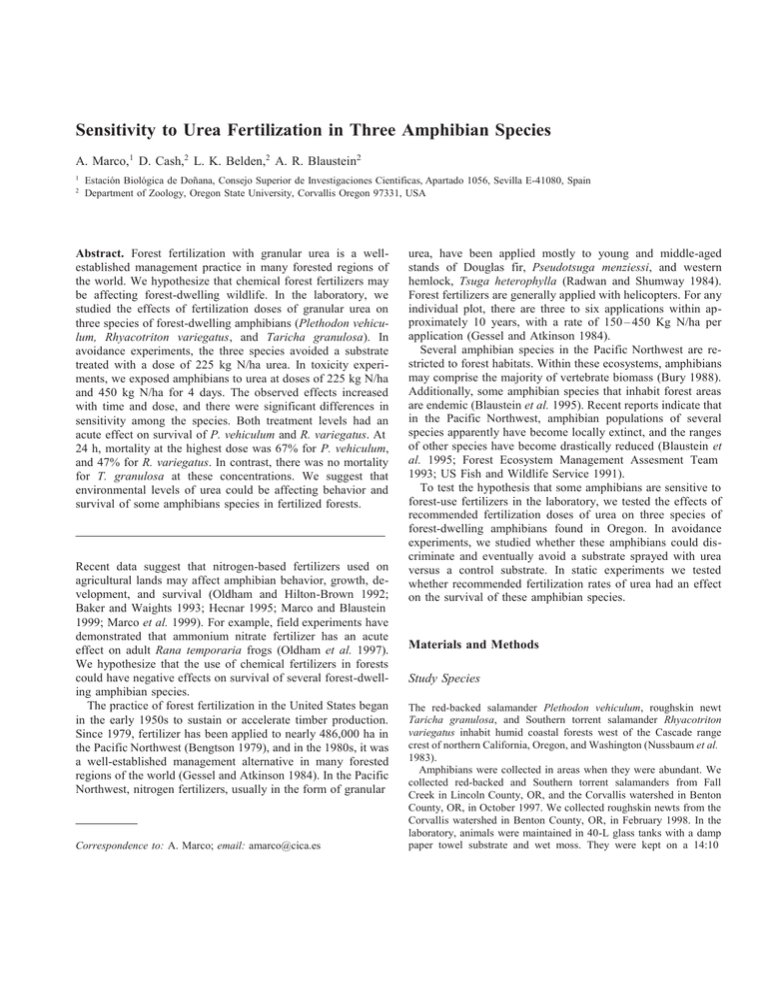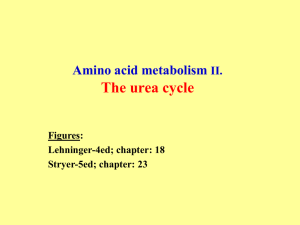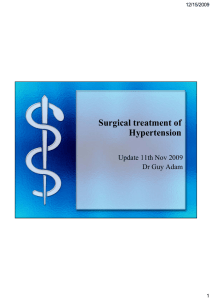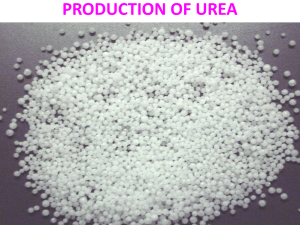archiv.doc
advertisement

Sensitivity to Urea Fertilization in Three Amphibian Species A. Marco,1 D. Cash,2 L. K. Belden,2 A. R. Blaustein2 1 2 Estación Biológica de Doñana, Consejo Superior de Investigaciones Cientificas, Apartado 1056, Sevilla E-41080, Spain Department of Zoology, Oregon State University, Corvallis Oregon 97331, USA Abstract. Forest fertilization with granular urea is a wellestablished management practice in many forested regions of the world. We hypothesize that chemical forest fertilizers may be affecting forest-dwelling wildlife. In the laboratory, we studied the effects of fertilization doses of granular urea on three species of forest-dwelling amphibians (Plethodon vehiculum, Rhyacotriton variegatus, and Taricha granulosa). In avoidance experiments, the three species avoided a substrate treated with a dose of 225 kg N/ha urea. In toxicity experiments, we exposed amphibians to urea at doses of 225 kg N/ha and 450 kg N/ha for 4 days. The observed effects increased with time and dose, and there were significant differences in sensitivity among the species. Both treatment levels had an acute effect on survival of P. vehiculum and R. variegatus. At 24 h, mortality at the highest dose was 67% for P. vehiculum, and 47% for R. variegatus. In contrast, there was no mortality for T. granulosa at these concentrations. We suggest that environmental levels of urea could be affecting behavior and survival of some amphibians species in fertilized forests. Recent data suggest that nitrogen-based fertilizers used on agricultural lands may affect amphibian behavior, growth, development, and survival (Oldham and Hilton-Brown 1992; Baker and Waights 1993; Hecnar 1995; Marco and Blaustein 1999; Marco et al. 1999). For example, field experiments have demonstrated that ammonium nitrate fertilizer has an acute effect on adult Rana temporaria frogs (Oldham et al. 1997). We hypothesize that the use of chemical fertilizers in forests could have negative effects on survival of several forest-dwelling amphibian species. The practice of forest fertilization in the United States began in the early 1950s to sustain or accelerate timber production. Since 1979, fertilizer has been applied to nearly 486,000 ha in the Pacific Northwest (Bengtson 1979), and in the 1980s, it was a well-established management alternative in many forested regions of the world (Gessel and Atkinson 1984). In the Pacific Northwest, nitrogen fertilizers, usually in the form of granular Correspondence to: A. Marco; email: amarco@cica.es urea, have been applied mostly to young and middle-aged stands of Douglas fir, Pseudotsuga menziessi, and western hemlock, Tsuga heterophylla (Radwan and Shumway 1984). Forest fertilizers are generally applied with helicopters. For any individual plot, there are three to six applications within approximately 10 years, with a rate of 150 – 450 Kg N/ha per application (Gessel and Atkinson 1984). Several amphibian species in the Pacific Northwest are restricted to forest habitats. Within these ecosystems, amphibians may comprise the majority of vertebrate biomass (Bury 1988). Additionally, some amphibian species that inhabit forest areas are endemic (Blaustein et al. 1995). Recent reports indicate that in the Pacific Northwest, amphibian populations of several species apparently have become locally extinct, and the ranges of other species have become drastically reduced (Blaustein et al. 1995; Forest Ecosystem Management Assesment Team 1993; US Fish and Wildlife Service 1991). To test the hypothesis that some amphibians are sensitive to forest-use fertilizers in the laboratory, we tested the effects of recommended fertilization doses of urea on three species of forest-dwelling amphibians found in Oregon. In avoidance experiments, we studied whether these amphibians could discriminate and eventually avoid a substrate sprayed with urea versus a control substrate. In static experiments we tested whether recommended fertilization rates of urea had an effect on the survival of these amphibian species. Materials and Methods Study Species The red-backed salamander Plethodon vehiculum, roughskin newt Taricha granulosa, and Southern torrent salamander Rhyacotriton variegatus inhabit humid coastal forests west of the Cascade range crest of northern California, Oregon, and Washington (Nussbaum et al. 1983). Amphibians were collected in areas when they were abundant. We collected red-backed and Southern torrent salamanders from Fall Creek in Lincoln County, OR, and the Corvallis watershed in Benton County, OR, in October 1997. We collected roughskin newts from the Corvallis watershed in Benton County, OR, in February 1998. In the laboratory, animals were maintained in 40-L glass tanks with a damp paper towel substrate and wet moss. They were kept on a 14:10 light:dark photoperiod at 15°C and were periodically fed crickets. Animals were in captivity for at least 4 days before we began our experiments. Each test animal was used in only one experiment. Avoidance Experiments In avoidance experiments, we tested if amphibians could discriminate between a substrate sprayed with urea versus a control substrate with no urea. The experiments were conducted in the laboratory at 15°C under artificial incandescent light with a natural photoperiod. For each trial, we used a rectangular plastic container (32 X 18 X 8 cm) as a testing chamber. Each half of the floor of a container was lined with paper towels. We sprayed prilled urea in the treatment side of the container at a dose of 225 kg N/ha. The spraying of urea on the left or right side of the container was determined randomly. Paper towels were placed 2 cm apart to minimize diffusion of urea from the treatment side to the control side (no urea). The walls of the containers were not covered by the paper towels and thus had no urea. Before each test, paper towels were sprayed with dechlorinated water to dissolve the granular urea and to control for potential differences in moisture level between the sides. For each trial, we introduced a single salamander into the center of each container and recorded the side of the container occupied by each salamander every 2 min for 1 h. If the test animal was located in the middle of the enclosure, we used the position of the salamander’s snout to assign location. We also recorded if the animal was in the bottom or on the walls of the container. All containers were carefully rotated 180° every 15 min to avoid any bias of animal orientation in the room. Toxicity Experiments In static experiments, we tested whether adults of three amphibian species were sensitive to urea at recommended fertilization doses. The experiments were conducted in the laboratory at 15°C under artificial incandescent light with a natural photoperiod. Forty-five individuals of each species were used in every experiment (3 treatments and 15 replicates per treatment). Fifteen animals were exposed to urea at a dose of 450 kg N/ha, 15 were exposed to urea at a dose of 225 kg N/ha, and finally 15 control animals were not exposed to urea. Tests were conducted in rectangular plastic containers (32 X 18 X 8 cm) for 96 h. The 45 containers for each experiment were randomly assigned to one of three experimental conditions. The floor of each container was lined with four layers of paper towels. We spread the urea on the floor of the treatment containers. Then paper towels of all containers were sprayed with dechlorinated tap water to dissolve the granular urea and to humidify the area. We used dechlorinated tap water that was chemically treated to remove ammonia, chlorine, chloramine, and heavy metals and to buffer pH. When the urea was totally dissolved, we introduced a single salamander into the center of each container. All the experiments were conducted for 96 h. Mortality and the presence of abnormalities were monitored and dead animals were removed every 12 h. Analysis of Data In the avoidance experiment and for each trial, we calculated the number of observations out of 30 (1 observation every 2 min for 60 min) that the test animal spent on each side of the testing container. We then used a Wilcoxon signed-ranks test (two-tailed) to determine whether the salamanders spent significantly more time on one side compared to the expected 50% (15 observations). We also used a Wilcoxon signed-ranks test (two-tailed) to determine whether the test animals spent significantly more time in the floor of the container (with urea in the treatment containers) when they were in the treatment or the control side. To determine if mortality differed among treatments, or among species, we used Chi-square tests, where the variable was the absolute frequency of dead animals at different times (12–96 h). Results Avoidance Experiments Nine of 20 P. vehiculum tested were more often found on the side of the container with urea. The mean number of observations spent on the side without urea was not significantly greater than 50% (Wilcoxon signed-ranks test, Z = 0.348, p = 0.728, n = 20; Figure 1). However, when salamanders were in the urea side of the container, they were preferentially found on the walls of the container (Wilcoxon signed-ranks test, Z = 2.929, p = 0.003, n = 20, Figure 1). When salamanders were in the control side of the container, they were found with similar frequency either on the floor or on the walls (Wilcoxon signed-ranks test, Z = 0.284, p = 0.776, n = 20; Figure 1). Seventeen of 20 R. variegatus tested were more often found on the control side of the container. The mean number of observations spent on the side without urea was significantly greater than 50% (Wilcoxon signed-ranks test, Z = 2.688, p < 0.01, n = 20, Figure 1). This species was found with low frequency on the walls of the container (Wilcoxon signed-ranks test, Z = 2.260, p = 0.036, n = 20). Sixteen of 20 T. granulosa tested were more often found on the control side of the container. The mean number of observations spent on the side with urea was significantly lower than 50% (Wilcoxon signed-ranks test, Z = 3.435, p < 0.001, n = 20, Figure 1). This species was found with very low frequency on the walls of the container (Wilcoxon signed-ranks test, Z = 3.800, p < 0.001, n = 20). Toxicity Experiments No mortality occurred in control tanks. The observed effects increased with both concentration and time, and there were significant differences in sensitivity among species (Figures 2 and 3). Both doses of urea had an acute effect on survival of P. vehiculum and R. variegatus. For the urea doses of 225 kg N/ha and at 48 h, P. vehiculum and R. variegatus had a mortality of 47%. At 12 h, mortality at the highest doses of urea was 60% for P. vehiculum and 40% for R. variegatus. At 48 h and at 450 kg N/ha, 14 of 15 P. vehiculum and 12 of 15 P. vehiculum died. T. granulosa had no mortality at both urea concentrations after 96 h of exposure. Sensitivity to urea increased with concentration in P. vehiculum (Chi-square test, x = 46.64, p < 0.001, df = 7) and in R. variegatus (Chi-square test, x = 19.10, p < 0 01, df = 7). Sensitivity to urea at 450 kg N/ha was similar between the two terrestrial salamanders (P. vehiculum and R. variegatus)(Chi-square test, x = 4.02, p = 0.78, df = 7, Figure 3), but sensitivity to urea showed differences between both species at the concentration of 225 kg N/ha (Chi-square test, x = 17.91, p = 0.012, df = 7). P. vehiculum was more sensitive Fig. 1. Effect of 225 kg N/ha of granular urea in substrate selection by adults of three amphibian species. Observations were recorded every 2 min over a period of 1 h (60 observations by each trial) Fig. 2. Sensitivity to different concentrations of granular urea (45: 0:0) of Plethodon vehiculum adults after an terrestrial exposure of 96 h in the laboratory. Urea concentrations correspond to common doses of urea fertilizers applied on forests in the Pacific Northwest. We used 15 replicates for each treatment. Adults of the rough-skin newt showed no mortality at both experimental urea concentrations during the first hours of exposure, but after 48 h of exposure R. variegatus was more sensitive (Figure 2). Discussion Our results show an acute toxic effect of dissolved urea to adult terrestrial amphibians in the laboratory. The three species avoided substrates with dissolved urea. Adults of the redbacked salamander and Southern torrent salamander died after few hours of exposure to recommended fertilization rates of urea. Rough-skin newts had no mortality in urea treatments. Oldham et al. (1997) found a high sensitivity of adult common frogs (R. temporaria) to granular ammonium nitrate fertilizer at concentrations below those recommended for field application. However, these authors indicated that the acute affect disappeared a few hours after fertilizer application, when the fertilizer dissolved in the soil. Adult R. temporaria were affected by fertilizers when they migrated over land. In our experiments, amphibians were very sensitive to urea after few hours of exposure. Granular urea is less soluble and dissolves in the soil more slowly than ammonium nitrate does. Fig. 3. Sensitivity to different concentrations of granular urea (45: 0:0) of Rhyacotriton variegatus adults after an terrestrial acute exposure of 96 h in the laboratory. Urea concentrations correspond to common doses of urea fertilizers applied on forests in the Pacific Northwest. We used 15 replicates for each treatment. Adults of the rough-skin newt showed no mortality at both experimental urea concentrations Thus, amphibians may be exposed to urea on the substrate after fertilizer application for longer periods. Moreover, we believe that in forest ecosystems, many terrestrial amphibians would be exposed to fertilizers or other chemicals not only when they are over the substrate but even when fertilizers dissolve in the forest soil. Members of the amphibian families Plethodontidae, Rhyacotritonidae, Ascaphidae, Dicamptodontidae, and Salamandridae live under surface debris, under gravel or stones, in decaying logs, or in soil burrows and crevices in the forest canopy (Blaustein et al. 1995; Nussbaum et al. 1983). In these microhabitats, time of exposure to chemicals for amphibians would also be longer. We suggest two possible mechanisms to explain the toxicity of urea to amphibians in our experiments. Urea-fertilized soils may become saline with low water potentials. The skin of amphibians behaves as a semipermeable membrane, and the osmotic flow of water is proportional to the osmotic gradient between the medium and the animal’s body fluids (Shoemaker et al. 1992). Relatively few species can survive well in salinities that exceed the normal osmotic concentrations. Licht et al. (1975) found that the salinity tolerance of salamanders naturally exposed to saline conditions (Batrachoseps sp.) was higher than the tolerance of salamanders from inland. Salamanders from inland populations only were able to acclimate to water solutions that were isosmotic with the blood. The reduced water potential that results from increased urea concentrations in the substrate and the air may impede the organisms to maintain their water balance (Jørgensen 1997). Alternatively, urea may transform to ammonium and unionized ammonia in the substrate and in the air. Ammonia has been reported to be acutely toxic to organisms at low concentrations. Ammonia may enter in the amphibians through the skin and lungs causing, in extreme cases, convulsions, coma, and death (Environmental Protection Agency 1986). In the present study we observed interespecific variability in sensitivity to urea. Rough-skin newts were very tolerant to high urea concentrations, whereas red-backed salamanders and Southern torrent salamanders were very sensitive. This interspecific variability is probably related with interspecific differences in the ability to withstand dry conditions and the degree of development of lungs. Rough-skin newts are much more terrestrial and consequently better adapted to dry conditions than the other two studied species (Nussbaum et al. 1983). Moreover, the red-backed salamander has no lungs and lungs of the Southern torrent salamander are greatly reduced in size, while the rough-skin newt has well-developed lungs (Duellman and Trueb 1994). The advantage of lung exchange, with respect to water balance, is that lungs lose less water than exposed wet skin. Salamanders that lack or have reduced lungs exchange respiratory gases almost exclusively across cutaneous surfaces. These salamanders usually are more sensitive to water losses in saline environments and have more permeable skins (to water and probably to other substances, such as ammonia) than salamanders that can respire through well-developed lungs (Shoemaker et al. 1992). Species that mainly depend on cutaneous respiration and, consequently, have more permeable skins are probably more susceptible to the negative effects of urea and ammonia pollution. Interspecific variability in sensitivity to chemical fertilizers has also been found by Marco et el. (1999) for pond-breeding amphibian species. These authors found that nitrate and nitrite differentially affected the larvae of some amphibian species. These results suggest that urea-based fertilizers could be affecting the survival of at least these two amphibian species in fertilized forests. R. variegatum is considered at high risk to viability, and P. vehiculum is considered at moderately high risk to viability (Forest Ecosystem Management Assessment Team 1993; Thomaset et al. 1993). Several other amphibians that inhabit in similar habitats could be also sensitive to presence of urea in the soil. Urea levels in soil and water should be monitored in these areas. Further studies are necessary to test the toxic effects of urea fertilizers to amphibians in the field. Acknowledgements. We thank Audrey Hatch, Erica Wildy, Ole Stabell, Kambei Shimada, Gorobey Katayama, and Heihachi Itayashida for their help. Funding was provided by the Ministry of Education and Culture of Spain (Grant E95-16796691 to A. Marco), Oregon State University (Department of Zoology Research Funds), and National Science Foundation of USA (Grant DEB 9423333 to A. R. Blaustein). References Baker J, Waights V (1993) The effect of sodium nitrate on the growth and survival of toad tadpoles (Bufo bufo) in the laboratory. Herpetol J 3:147–148 Bengtson GW (1979) Forest fertilization in the United States: progress and outlook. J Forestry 78:222–228 Blaustein AR, Beatty JJ, Olson DH, Storm RM (1995) The biology of amphibians and reptiles in old-growth forests in the Pacific Northwest. General Technical Report PNW-GTR337, US Department of Agriculture, Portland, OR Bury RB (1988) Habitat relationships and ecological importance of amphibians and reptiles. In: Raedke KJ (ed) Streamside management: riparian wildlife and forestry interactions. University of Washington, Seattle, WA Duellman WE, Trueb L (1994) Biology of amphibians. The Johns Hopkins University Press, Baltimore, MD Environmental Protection Agency (1986) Quality criteria for water. US Environmental Protection Agency, EPA 440/5-86-001, Washington DC Forest Ecosystem Management Assesment Team (1993) Forest ecosystem management: an ecological, economic, and social assesment. US Department of Agriculture and US Department of Interior, Portland, OR Gessel SP, Atkinson WA (1984) Use of fertilizers in sustained productivity of Douglas-fir forests. In: Stone EL (ed) Forest soils and treatment impacts. The University of Tennessee, Knoxville, TN, pp 67– 88 Hecnar SJ (1995) Acute and chronic toxicity of ammonium nitrate fertilizer to amphibians from southern Ontario. Environ Toxicol Chem 14:2131–2137 Jørgensen CB (1997) Urea and amphibain water economy. Comp Biochem Physiol 117: 161–170 Licht P, Feder ME, Bledsoe S (1975) Salinity tolerance and osmoregulation in the salamander Batrachoseps. J Comp Physiol 102:123– 134 Marco A, Blaustein AR (1999) The effects of nitrite on behavior and metamorphosis in Cascades frogs (Rana cascadae). Environ Toxicol Chem 18:946 –949 Marco A, Quilchano C, Blaustein AR (1999) Sensitivity to nitrate and nitrite in some pond-breeding amphibians from the Pacific Northwest. Environ Toxicol Chem 18:2836 –2839 Nussbaum RA, Brodie ED Jr, Storm RM (1983) Amphibian and Reptiles of the Pacific Northwest. University of Idaho Press, Moscow, ID Oldham RS, Hilton-Brown D (1992) Effect of agricultural fertilizers on amphibians (C): NPK granules tested separately. Contract No. F72-15-05, Nature Conservancy Council Oldham RS, Lathan DM, Hilton-Brown D, Towns M, Cooke AS, Burn A (1997) The effect of ammonium nitrate fertilizer on frog (Rana temporaria) survival. Agric Ecos Environ 61:69 –74 Radwan MA, Shumway JS (1984) Site index and selected soil properties in relation to response of Douglas-fir and Western hemlock to nitrogen fertilizer. In: Stone EL (ed) Forest soils and treatment impacts. The University of Tennessee, Knoxville, TN, pp 89 –104 Shoemaker VH, Hillman SS, Hillyard SD, Jackson DC, McClanahan LL, Withers PC, Wygoda ML (1992) Exchange of water, ions, and respiratory gases in terrestrial amphibians. In: Feder ME, Burggren WW (eds) Environmental physiology of amphibians. The University of Chicago Press, Chicago, IL pp 125–150 Thomas JW, Raphael MG, Anthony RG (1993) Viability assessments and management considerations for species associated with latesuccessional and old-growth forests of the Pacific Northwest. US Department of Agriculture, Washington, DC US Department of the Interior, Fish and Wildlife Service (1991) Endangered and threatened wildlife and plants: animal candidate review listing as endangered or threatened species, proposed rule. Part VIII. Federal Register, 56:58803–58836









